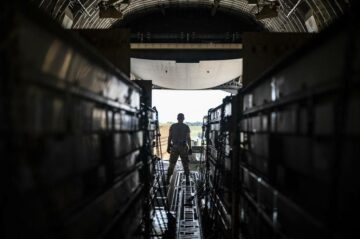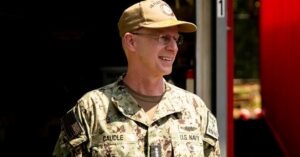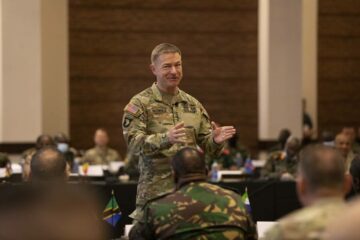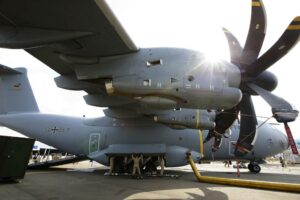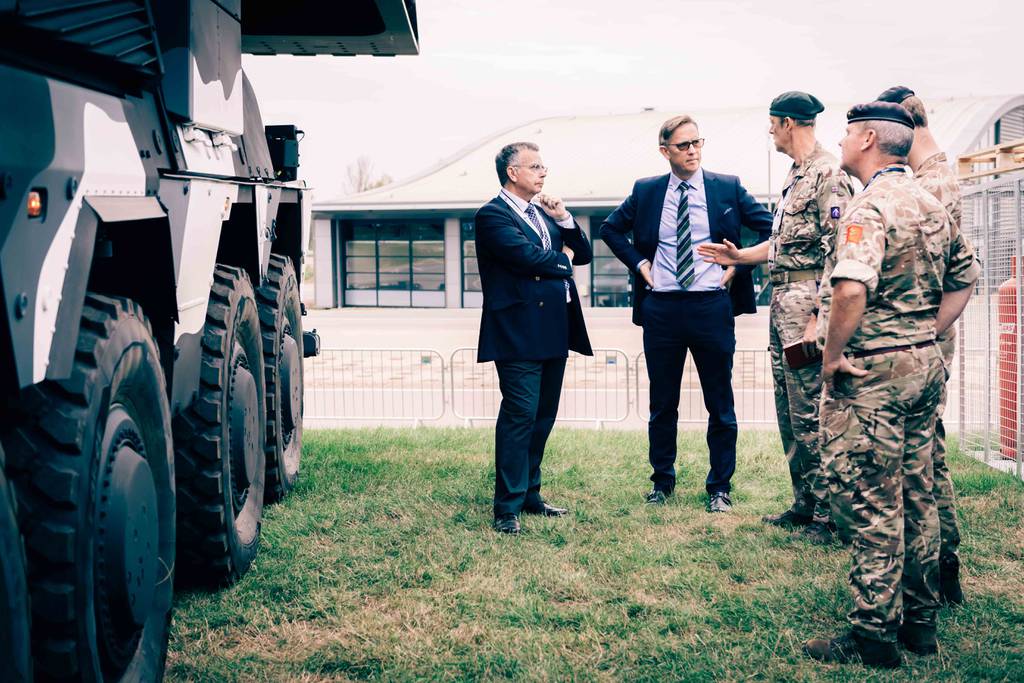
LONDON — Critics complain Britain’s defense procurement effort is broken. Andy Start, the CEO of the Defence Equipment & Support (DE&S) arm of the Ministry of Defence, says the performance data proves otherwise.
Whoever is closer to the truth, Start, who has been in the job for 12 months having moved from a senior position in industry, is at the heart of major changes to procurement and the wider defense acquisition cycle pushed by the MoD.
Driven in part by lessons from the war in the Ukraine and the rapidly evolving nature global threats, the DE&S boss pinpoints areas where the ministry can do better, including accelerating the delivery of equipment into the hands of the military.
Philip Hammond, the former defense secretary, used to talk about making procurement match fit during his tenure. Are you match fit ?
Having read a lot about [the problems of] DE&S before joining I expected to find one thing. When I got inside the organization I found the data told me quite a different story. In summary, the organization is good today if you compare it to its global peers and in terms of delivery of what is asked of it. We deliver about 98% of key user requirements, and 89 % of our strategic milestones on time. We don’t get everything right and there are big complex, particularly international programs, that run very long. We need to do better on that, but more generally we need to do better because the threats are changing, not because we are not delivering today.
Why is there such a divide between MoDs perception on procurement performance and the poor marks given by politicians, analysts and industry executives?
Part of the reason you get the disconnect is that DE&S only owns part of the acquisition cycle today. The issues we have, particularly the speed of decision making prior to contract award, are features of the wider acquisition system, not the DE&S part of it.
Poor accountability, broken and ponderous – those were some of the unflattering terms used by the Parliamentary Defence Committee to describe DS&E in a recent report. What’s your response?
We welcomed their decision to look at procurement. It allowed us to give them real data about DE&S performance. Whilst the report was not without criticism the things they focused on in their recommendations are the things we are already working on, or have already done. Also, I was delighted they recognized the work we have done for the Ukraine, which is spectacular.
So the Committee report was a fair assessment of where you are?
There were some assessments I wouldn’t make in terms of their perception of where we are, but I’m very comfortable with their recommendations, even if I wouldn’t characterize the current state of DE&S the way they would. They picked three problem programs, but you have to look at that in the context of the scale of what we deliver. Which isn’t to say we can’t do a lot better.
What will change at DE&S look like?
A.We are doing an awful lot in terms of changing our strategy, restructuring DE&S and the wider MoD to adapt the U.K.’s acquisition model in a way which recognizes the fact we want to deliver more, and deliver it more quickly. We have traditionally delivered acquisition focused on lowest cost, not necessarily focusing on time, it is something that has to shift.
An MoD Command Paper released in July talked about allowing a maximum of five years for delivery of regular acquisition programs and three years for digital programs. How will it work?
Over the two years to December 2022, our data indicates that the average time to front-line delivery across the MoD portfolio reduced by a year. We need to go further; all DE&S programs will now actively look for opportunities to take time out across the whole program lifecycle.
They will seek to reduce the time taken from approval to proceed with a particular solution through to delivery to the users. We will be proportionate in our approach with our most complex programs likely to take longer. Industry has a critical part to play in delivering at greater pace and our contracting approaches need to incentivize them accordingly. The new strategy really puts pressure on the system to accelerate the pace of decision making pre-contract award and to ensure they don’t overreach in terms of the technology readiness of the equipment they are selecting.
What are some of the key elements of the new DE&S restructuring?
Put simply, the mission can be termed “Today, tomorrow, together.” Today we need to drive up the availability of the current assets. For example we have doubled the number of flying hours on Typhoon over the last 12 months.
We have backed that up by developing a unit called the Defence Availability Control Center which has a control room in our HQ in Abbeywood allowing us to track the availability of all our assets globally from a single room.
Tomorrow, it’s about spinning in technology with greater speed. In terms of spiral development we have done some amazing work, a lot of it for Ukraine, including the attack drone you have heard the prime minister talk about (in May 2023). Also we have done a lot in the intelligence, surveillance and reconnaissance space.
The together bit is recognition that we need to treat industry as a fundamental part of the defense ecosystem. We have shifted to involving industry at highly classified levels very early in the requirements process to make sure we are specifying the next generation of technology we want.
How will this impact the DE&S operating model?
The big shift we have made in the operating model is for the first time to include all of defense, industry and a bunch of academics, more than 1,000 people, in the process of redesigning our defense acquisition requirements. We have produced an outline shape of what the new end-to-end acquisition model might look like, which we call the Infinity Loop. It’s a revised way of thinking about acquisition that starts from recognition that the most important thing is current operational delivery and how you spiral up from equipment delivery, rather than thinking of acquisitions as a green field site that happens in isolation.
The result will be a restructure in the way DE&S operates and a move away from a structure of operating in silos of land, sea, air and strategic enablers to an operating model which is much more integrated.
We are still in the design process for that, it will take us through to next summer to implement because it’s a massive change. We have defined the four major blocks of the new organization and we have done the design work for the first of those called the Defense Gateway which is the bit that will manage the interface between DE&S the front line commands, industry and our allies.
The bit I’m talking about is DE&S, but there is recognition that the whole acquisition cycle in the U.K. needs to change and the wider defense operating model needs to change too.
The timing of the proposed changes takes you very close to a general election expected in 2024. Will that pose difficulties?
A lot of this restructuring is about recognizing that in the context of the new threat any government would want to make these changes. Some of it may involve political decisions, so we may not get it all done prior to an election, but this work is absolutely necessary. The stuff we are doing in DE&S, any government would ask us to do.
People talk about Ukraine being a game changer. How is it changing the game for DE&S?
The first lesson is the focus on delivering to a max price within a max time and then varying the capability that you get later. This gave us a real feel that you can get 80% of the capability really quickly and then spiral up. That lesson is definitely learnt in terms of the underlying acquisition process.
The MoD has talked about 80% being good enough for decades, with little result. Why should it work this time?
I completely agree, it requires strong governance. If you asked any end user in any environment what they want they will always specify the Ferrari whereas a Ford Focus might have been good enough. So you need strong governance and you need strong balance of investment processes that sit over the top of that. What the command paper recognizes is that where threat levels and the pace of innovation is, accelerating very long programs seeking high levels of requirement are not the way to do it.
What changes in-house did you make to manage Ukraine’s urgent requirements?
One of the things I’m most proud of at DE&S is the way we restructured to create an operations directorate led by a two-star major general that focused on ensuring we were responding to Ukraine’s needs at pace as well as considering our own operational changes.
As a consequence we got first orders out to Ukraine in 48 hours, which led to DE&S contributing £1.3 billion ($1.6 billion) of aid to Ukraine in the financial year 2022/23, out of a total U.K. contribution of £2.3 billion.
AUKUS will be one of the most complex multi-national procurement deals in decades. What’s your role going to be?
We are part of AUKUS Pillar 2 which covers all of the advanced technologies outside of the nuclear submarine sector covered by Pillar 1.
At the moment, most of the Pillar 2 discussions are in the area of military capability. At the DSEI exhibition in London this month I will be meeting my Australian and U.S. counterparts to talk about how we will put in place the practical operational structures around delivery of Pillar 2.
If we can demonstrate the partners’ industries can undertake collaborative development at high levels of classification, and we can also agree a shared understanding of the threat and the changes of threat together it will be a major step forward. If we can make that work from a policy perspective and collaborative perspective we have the opportunity to change how we think about pooling our development monies and intellectual property to get a win for all parties.
Does the F-35 program offer a template for AUKUS collaboration?
There are some really positive lessons out of Joint Strike Fighter in terms of what’s possible with collaborative development. We can do better with AUKUS if we can agree the right policy instruments and the right amount of sharing. With JSF there are still complications in the way design data moves around the system. I would like us to move to a place where we can freely share data within those industry players that are operating on AUKUS-specific programs. I’d like to be in a place where U.S., British and Australian design teams can share information amongst industry separately from sharing with government. Today it all has to go up through government and back down again. There is an opportunity for us all to become more efficient.
F-35 required hard yards to get where we are. The question is how do we take the best of that but remove some of the friction out of the system. There is a real commitment by the nations to do that and there has been really good progress in terms of creating the right mechanism for data sharing and so on.
Andrew Chuter is the United Kingdom correspondent for Defense News.
- SEO Powered Content & PR Distribution. Get Amplified Today.
- PlatoData.Network Vertical Generative Ai. Empower Yourself. Access Here.
- PlatoAiStream. Web3 Intelligence. Knowledge Amplified. Access Here.
- PlatoESG. Automotive / EVs, Carbon, CleanTech, Energy, Environment, Solar, Waste Management. Access Here.
- PlatoHealth. Biotech and Clinical Trials Intelligence. Access Here.
- ChartPrime. Elevate your Trading Game with ChartPrime. Access Here.
- BlockOffsets. Modernizing Environmental Offset Ownership. Access Here.
- Source: https://www.defensenews.com/global/europe/2023/09/11/uk-armaments-director-andy-start-readies-massive-acquisition-changes/
- :has
- :is
- :not
- :where
- $UP
- 000
- 1
- 12
- 12 months
- 2022
- 2023
- 2024
- 70
- a
- About
- absolutely
- academics
- accelerate
- accelerating
- accordingly
- accountability
- acquisition
- acquisitions
- across
- actively
- adapt
- advanced
- again
- Aid
- AIR
- All
- allowed
- Allowing
- already
- also
- always
- amazing
- amongst
- amount
- an
- Analysts
- and
- any
- approach
- approaches
- approval
- ARE
- AREA
- areas
- ARM
- around
- AS
- ask
- assessment
- assessments
- Assets
- At
- attack
- Australian
- availability
- average
- award
- away
- back
- backed
- Balance
- BE
- because
- become
- been
- before
- being
- BEST
- Better
- between
- Big
- Billion
- Bit
- Blocks
- BOSS
- British
- Broken
- Bunch
- but
- by
- call
- called
- CAN
- Can Get
- capability
- Center
- ceo
- change
- Changer
- Changes
- changing
- characterize
- classification
- classified
- Close
- closer
- collaboration
- collaborative
- comfortable
- commitment
- committee
- compare
- completely
- complex
- considering
- context
- contract
- contracting
- contributing
- contribution
- control
- Cost
- covered
- covers
- create
- Creating
- critical
- criticism
- Critics
- Current
- Current state
- cycle
- data
- data sharing
- Deals
- decades
- December
- decision
- Decision Making
- decisions
- defence
- Defense
- defined
- definitely
- delighted
- deliver
- delivered
- delivering
- delivery
- demonstrate
- describe
- Design
- design process
- developing
- Development
- DID
- different
- difficulties
- digital
- Director
- discussions
- divide
- do
- doing
- done
- Dont
- doubled
- down
- drive
- drone
- during
- e
- Early
- ecosystem
- efficient
- effort
- Election
- elements
- end
- end-to-end
- enough
- ensure
- ensuring
- Environment
- equipment
- Ether (ETH)
- Even
- everything
- evolving
- example
- executives
- exhibition
- expected
- fact
- fair
- Features
- feel
- Ferrari
- field
- financial
- Find
- First
- first time
- fit
- five
- flying
- Focus
- focused
- focusing
- For
- Ford
- Former
- Forward
- found
- four
- friction
- from
- front
- front-line
- fundamental
- further
- game
- game-changer
- gateway
- gave
- General
- generally
- generation
- get
- Give
- given
- Global
- Globally
- Go
- going
- good
- got
- governance
- Government
- greater
- Green
- hammond
- Hands
- happens
- Hard
- Have
- having
- heard
- Heart
- High
- highly
- his
- HOURS
- How
- hq
- HTTPS
- i
- if
- image
- images
- Impact
- implement
- important
- in
- incentivize
- include
- Including
- indicates
- industries
- industry
- Infinity
- information
- Innovation
- inside
- instruments
- integrated
- intellectual
- intellectual property
- Intelligence
- Interface
- International
- into
- investment
- involve
- involving
- isolation
- issues
- IT
- ITS
- Job
- joining
- joint
- jpg
- July
- Key
- Kingdom
- Land
- Last
- later
- Led
- lesson
- Lessons
- levels
- lifecycle
- like
- likely
- Line
- little
- London
- Long
- longer
- Look
- look like
- Lot
- lowest
- made
- major
- make
- Making
- manage
- massive
- Match
- max
- maximum
- May..
- me
- mechanism
- meeting
- might
- Milestones
- Military
- ministry
- Mission
- model
- moment
- Month
- months
- more
- more efficient
- most
- move
- moved
- moves
- much
- multi-national
- my
- Nations
- Nature
- necessarily
- necessary
- Need
- needs
- New
- news
- next
- now
- nuclear
- number
- of
- offer
- on
- ONE
- only
- operates
- operating
- operational
- Operations
- opportunities
- Opportunity
- or
- orders
- organization
- otherwise
- our
- out
- outline
- outside
- over
- overreach
- own
- owns
- Pace
- Paper
- Parliamentary
- part
- particular
- particularly
- parties
- peers
- People
- perception
- performance
- perspective
- picked
- Pillar
- Place
- plato
- Plato Data Intelligence
- PlatoData
- Play
- players
- policy
- political
- Politicians
- poor
- portfolio
- position
- positive
- possible
- Practical
- pressure
- price
- Prime
- prime minister
- Prior
- Problem
- problems
- proceed
- process
- processes
- procurement
- Produced
- Program
- Programs
- Progress
- property
- proportionate
- proposed
- proud
- proves
- pushed
- put
- Puts
- question
- quickly
- rapidly
- rather
- Read
- Readiness
- real
- really
- reason
- recent
- recognition
- recognized
- recognizes
- recognizing
- recommendations
- redesigning
- reduce
- Reduced
- regular
- released
- remove
- report
- required
- requirement
- Requirements
- requires
- responding
- response
- restructure
- restructuring
- result
- right
- Role
- Room
- Run
- s
- say
- says
- Scale
- SEA
- secretary
- sector
- Seek
- seeking
- selecting
- senior
- Shape
- Share
- share information
- shared
- sharing
- shift
- shifted
- should
- silos
- simply
- single
- sit
- site
- So
- solution
- some
- something
- Space
- spectacular
- speed
- start
- starts
- State
- Step
- Still
- Story
- Strategic
- Strategy
- strike
- strong
- structure
- structures
- such
- SUMMARY
- summer
- support
- sure
- surveillance
- system
- Take
- taken
- takes
- Talk
- talking
- teams
- Technologies
- Technology
- template
- terms
- than
- that
- The
- The Area
- the United Kingdom
- their
- Them
- then
- There.
- These
- they
- thing
- things
- think
- Thinking
- this
- those
- threat
- threats
- three
- Through
- time
- timing
- to
- today
- together
- told
- tomorrow
- too
- top
- Total
- track
- traditionally
- treat
- truth
- two
- U.K.
- u.s.
- Uk
- Ukraine
- Ukraines
- underlying
- understanding
- undertake
- unit
- United
- United Kingdom
- urgent
- us
- used
- User
- users
- very
- want
- war
- was
- Way..
- we
- welcomed
- WELL
- were
- What
- What is
- when
- whereas
- which
- Whilst
- WHO
- whole
- why
- wider
- will
- win
- with
- within
- without
- Work
- working
- would
- year
- years
- you
- Your
- zephyrnet



